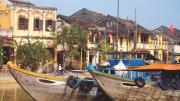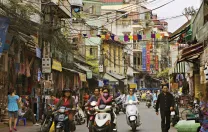In central Vietnam, well north of the tropical Mekong Delta (see “A Nation, Building”), Fulbright School graduates are also involved in changing public administration, commerce, and perhaps even governance.
Danang, the largest city in the country’s narrow “neck,” exemplifies the promise and problems of modernization and increasing complexity in a mixed economy. New office towers rise near the Han River, and the waterfront features an expansive sports complex and a row of lavish wedding-banquet halls (the “For You Palace,” the “White Dove,” etc.)—evidence of a rising consumer class. Handsome new bridges, including one decked out like a happy dragon figure, cross the river to the ocean-facing eastern edge of the city, where luxury resorts, including Hyatt Regency and Crowne Plaza properties, spill down the shore, intermingled with villas on offer for $2 million: the face of Danang’s services-oriented development.
But there are downsides, too. Farther south of the city center, the groomed resorts give way to abandoned construction sites and cleared but vacant land: local evidence of unrealized expectations, impractical projects, and the world property bust. Moreover, in Vietnam’s pell-mell rush for growth, expensive infrastructure often rises without a clear rationale—as in the case of competing, underused international airports for Danang and Hue, barely 50 miles apart.
Nguyen The Thanh Hien now plays a role in lessening the odds that mistakes of the latter sort will recur. A staff member of Danang’s investment and development fund—a local infrastructure agency that channels World Bank and other funds to hospital, school, road, and bridge projects—Hien says she “recognized that I lacked knowledge of appraisal of public investments and public finance.” The Fulbright Economics Teaching Program (FETP) “is the only program in the country that provides these courses,” so she enrolled in 2011. Her agency assures that proposals conform to the city plan, environmental standards, and so on. But now that she has completed her studies, she brings financial rigor to the review as well. In prospect is the relocation of Danang’s freight-container port, which will release prime downtown land for tourism-related redevelopment; her thesis was an appraisal of the project’s economics. How do her 33 colleagues in the agency react to this new approach? Hien says diplomatically that others in the agency have “real-world” experience that meshes with her academic tools, making for productive exchanges of views. “I show them this problem or that problem,” she continues, “and they always listen to me on analytical issues.”
And how might tourism expand? Ever since Vietnam created a legal framework for private businesses early in the previous decade, both entrepreneurs and established enterprises have felt their way, sometimes gingerly, toward newly permitted opportunities. Le Vinh Quang, whose father ran a small business and served on the People’s Council in Hoi An, a small city south of Danang, graduated from the Danang University of Science and Technology in 1993 and worked in a bank and an industrial company before meeting Thomas Vallely and some early graduates of FETP in 2001. He enrolled that year; the one-year experience, he says, “changed my life,” conferring knowledge of macro- and microeconomic management and providing the chance “to meet with other students from all over the country.”
He emerged, he says, confident that he “can work in either the public sector or the private sector”—in a country where the very notion of those distinct sectors meant something novel compared to his father’s experience. Quang was hired as central Vietnam manager for the country’s largest taxi company; in 2004, he became the first self-nominated candidate for Danang’s People’s Council to win election (he is the only business owner to serve, and is now a member of the economics and budget team); and after several successive jobs, in 2009, he established his own taxi company. Today, riding the tourism industry’s momentum, and applying lessons in marketing from the Fulbright curriculum, Quang’s company operates 350 cabs in three cities, is about to expand to a fourth, and employs 1,000 people. As he bridges business and government, Quang says, he is pursuing a third sector, philanthropy, by supporting a local hospital and funding scholarships. And having launched himself on a busy trajectory, he projects still more: he has returned to the Fulbright School to write a thesis on the sustainability of Danang’s public finances, and plans to seek election to the National Assembly in 2016. Rattling off the names of FETP classmates countrywide from a dozen years ago, he notes how many of them returned from school to staff jobs, and are now directing departments, managing companies, or advising senior government leaders.
As valuable as entrepreneurship may be for Vietnam’s political and economic prospects, the disposition of its dominant state-owned enterprises (SOEs) a quarter-century after doi moi took hold may be even more critical (see main text). That national drama plays out provincially, too. Half an hour’s drive south of Danang, in the historic core of Hoi An—an intact trading port of low-rise, ocher buildings designated a UNESCO World Heritage Site—Nguyen Van Cu has lived and led a chapter in the Vietnamese transition. After studying economics in the early 1990s, he began working at a state-owned hospitality company. With the passage of the enterprise law at the beginning of the next decade, the city government planned to privatize it, but the change hung in limbo for five years. After a friend studied at FETP, Cu enrolled in 2007, intending to move thereafter to new work. Despite his earlier studies, he says, the intellectual challenge of this new curriculum was like the physical move to Ho Chi Minh City: “I was like a countryside guy going to the big city.”
During that year, the privatization proceeded, and the director wooed Cu back to an enterprise with new capital, different strategies, and a refreshed management. Today, as deputy general director of Hoi An Tourist Holding Company, he manages two sparkling hotels and a tour operation, with sales offices in Ho Chi Minh City, Hanoi, and Tokyo, and a multilingual staff of 500 who accommodate an almost entirely international clientele. The industry’s rapid growth during the past five years more than holds his interest, Cu says. So does the ability to put into practice the “different approaches” he mastered at FETP. For a country with Vietnam’s natural beauty and tourist assets—located just hours away from the rising wealth and burgeoning middle classes created elsewhere in Asia—Cu’s Hoi An story, multiplied manyfold, represents huge potential.










